In this post, we’ll explore nine SEO trends that are shaping 2025.
By the end, you’ll understand how AI is transforming search engine optimization and discover actionable strategies to stay ahead of your competitors.
Let’s dive in.
1. AI-Generated SEO Content Is Now Mainstream
AI writing tools have made it easier than ever to produce large volumes of content quickly, allowing websites to publish more articles and target a wider range of keywords. Adoption is skyrocketing—according to CoSchedule, 85% of marketers now use AI tools for content creation.
However, content generated solely by AI often lacks uniqueness and depth. Writing articles on topics already covered by competitors can result in content that feels repetitive or generic.
This matters because Google prioritizes content quality over the method of production. As Google states:
“Our focus on the quality of content, rather than how content is produced, is a useful guide that has helped us deliver reliable, high-quality results to users for years.”
Without careful editing and the addition of original insights, examples, or data, AI content may fail to stand out, impacting search rankings and visibility in features like AI Overviews and AI Mode.
How to Leverage This Trend
-
Use AI for the first draft: Let AI tools generate a starting point to save time.
-
Enhance with unique content: Add real examples, stories, data, and insights that reflect your brand expertise.
This two-step approach allows you to create unique, high-quality content efficiently while meeting Google’s expectations.
Tools to try:
-
Semrush Content Toolkit – Generate your first draft efficiently.
-
Topic Finder – Enter a primary topic, select your target location, and click “Find Topics” to uncover high-impact content ideas.

Topic Finder will then surface ideas based on real-time search data.
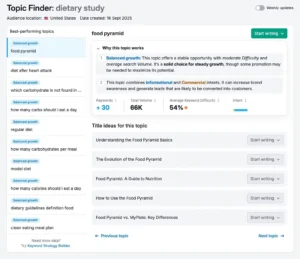
Next, click “Start Writing” and choose “Generate Article with AI” in the AI Article Generator.
You’ll be prompted to specify your audience location, title, target keywords, word count, and brand voice.
To optimize your content for search engines automatically, check the box next to “SEO Booster”, which uses up-to-date search data. Then, click “Create Article” to generate your full-length draft.
2. Alternatives to Google Are Becoming More Popular
Users are increasingly looking beyond Google for research, turning to other search engines and AI-driven platforms.
-
Bing has steadily increased its search market share in recent years.
-
Over half of U.S. consumers now begin product searches on Amazon rather than traditional search engines.
AI-powered search is also growing rapidly. Research suggests that traffic from AI platforms could surpass that from traditional search engines by 2028, signaling a major shift in how users find information online.
How to Leverage This Trend
-
Diversify your SEO efforts: Don’t focus solely on Google—optimize for Bing, Amazon, and other search engines relevant to your niche.
-
Explore AI search platforms: Consider how your content can appear in AI-driven answers and summaries.
-
Track new search patterns: Monitor where your audience is searching and adapt your content strategy accordingly.
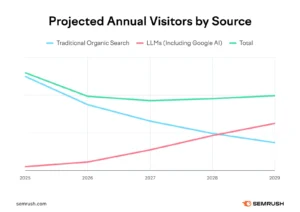
How to Leverage This Trend
Take a cue from Webflow by focusing on strategies that increase your visibility in AI-driven tools.
For example, Webflow is frequently cited in “best website builder” lists, such as the Zapier article below. These lists and references are often picked up by AI systems when determining which brands to recommend, giving Webflow more exposure to users exploring AI-powered search platforms.
To apply this strategy:
-
Aim for authoritative mentions: Get your brand featured in reputable lists, reviews, and guides.
-
Ensure content is AI-friendly: Structure content clearly so AI platforms can easily extract and reference it.
-
Monitor AI visibility: Track how your brand is being recommended in AI search results and adjust accordingly.
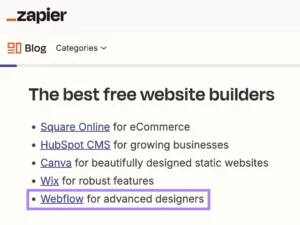
Plus, Webflow’s support team engages directly with users on Reddit. And Reddit is one of the most frequently cited sources in AI tools.
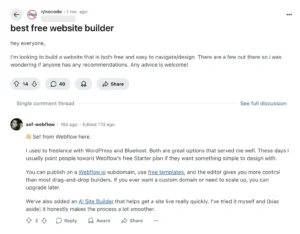
According to Semrush’s AI Traffic Dashboard, Webflow’s site received an estimated 64.3K visits from AI platforms in August. While this represents a small portion of the site’s overall traffic—about 0.7% of the 9.2 million visits estimated by Traffic Analytics—AI-driven visits have grown 47% since January, highlighting the rapid rise of AI as a traffic source.
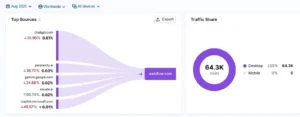
Webflow also reports that 8% of its new signups now come from AI search traffic, underscoring the growing importance of alternative search sources.
Here are some additional strategies to reach prospects who aren’t relying solely on Google:
-
Focus on Bing alongside Google – Submit your sitemap to Bing Webmaster Tools to help the search engine crawl your site more efficiently. Check out our Bing search guide for detailed optimization tips.
-
Structure your content thoughtfully – Create comprehensive, well-organized content that search engines and AI platforms can easily interpret.
-
Collaborate with social media teams – Optimize content for TikTok and Instagram search using platform-specific keywords and hashtags.
-
Strengthen your video efforts – Publish YouTube videos with optimized titles, descriptions, and transcripts to capture additional search traffic.
-
Apply technical SEO best practices – Ensure your website is fast, mobile-friendly, and secure, as these factors improve performance across both traditional and AI-driven search.
3. Matching Search Intent Is Even More Important
Both search engines and AI platforms increasingly prioritize content that aligns with user search intent. Creating content that truly satisfies what users are looking for can significantly improve your visibility and rankings.
According to Semrush’s Ranking Factors Study, text relevance is the most important Google ranking factor. This measures how well your content matches the user’s query, emphasizing that producing content purely for keywords is no longer enough—you need to address the intent behind the search.
How to Leverage This Trend
-
Understand your audience – Identify the questions, problems, and needs your audience has.
-
Analyze top-ranking content – See how competitors are meeting search intent and find opportunities to offer better, more complete answers.
-
Create comprehensive content – Include detailed explanations, examples, visuals, and FAQs to cover the topic thoroughly.
-
Use semantic keywords – Incorporate related terms and phrases that users are likely searching for to reinforce relevance.
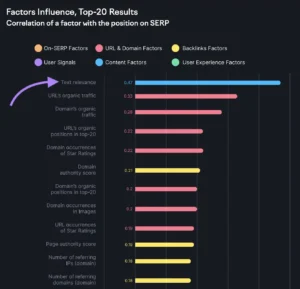
This concept is equally important for AI-driven tools. In many cases, alignment with search intent may be even more critical, given the highly specific questions users ask platforms like ChatGPT.
To capitalize on this trend, your pages should deliver the most helpful, precise information for each query, ensuring users—and AI systems—see your content as the best answer.
How to Leverage This Trend
-
Create new content aligned with search intent – Ensure every piece you publish directly addresses what users are looking for.
-
Update existing content – Refresh older pages to fully satisfy user queries and maintain relevance.
-
Analyze search intent for target keywords – Examine Google search results and AI tool responses to understand what users expect.
For example, a search for “iPhone 16 vs Samsung S25” on Google returns primarily detailed comparison articles that analyze features and prices. This indicates that users are looking for a side-by-side comparison to make an informed purchasing decision.
By understanding and matching search intent, your content is more likely to rank highly on search engines and be recommended by AI tools.
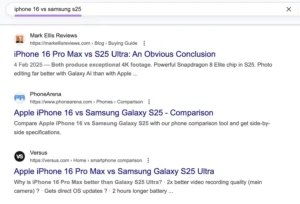
Searching the same query on ChatGPT produces a detailed breakdown of features and considerations to help users make an informed purchase decision, often accompanied by source citations.
This highlights that AI platforms prioritize content that directly addresses user intent while providing clear, trustworthy information.
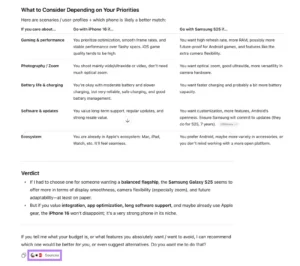
That said, search intent can sometimes be difficult to determine, especially since results are often personalized to individual users. To get a clearer understanding, use Semrush’s Keyword Overview tool.
Simply open the tool, enter your keyword or a list of keywords, and click “Search” to identify the primary intent behind each query. This provides a more definitive way to align your content with what users are actually looking for.
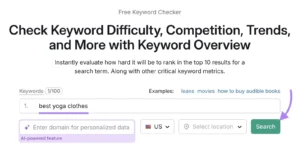
After searching, check the “Intent” widget in Semrush to see the intent type for each keyword:
-
Informational – Users want to learn something.
-
Navigational – Users are looking for a specific website or page.
-
Commercial – Users are researching products or services before buying.
-
Transactional – Users are ready to take action, such as making a purchase.
Understanding the keyword intent helps you create content that matches user expectations, improving your chances of ranking higher and satisfying both search engines and AI tools.
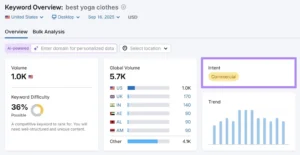
Next, scroll down to the “SERP Analysis” section and carefully review the pages listed. Pay attention to:
-
The subtopics they cover
-
How the articles are structured and formatted
-
The types of media, examples, or supporting details included
This analysis helps you identify gaps and opportunities to create content that better satisfies user intent and stands out in search results.
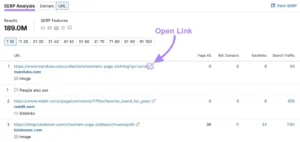
Finally, create new content or update existing pages to cover similar topics, but make sure to add your unique perspective, insights, and examples. This ensures your content stands out while fully satisfying user intent.
4. Credibility Holds More Weight
Google evaluates content based on Experience, Expertise, Authoritativeness, and Trustworthiness (E-E-A-T). While not a direct ranking factor, it influences human evaluators and AI recommendations.
How to Leverage This Trend
-
Include actual results, lessons learned, industry observations, statistics, and expert quotes.
-
Maintain author pages highlighting credentials (e.g., Bankrate’s dedicated author pages).
-
Use labels like “Reviewed by” to show content has been vetted.
-
Incorporate insights from relevant experts to boost AI citations.
Example: Bankrate scores 87/100 in AI Visibility Overview and is among the most cited finance sources in ChatGPT and Google AI Mode.
5. AI Visibility Is Becoming a Key SEO Metric
AI tools are changing how content is discovered. Traditional rankings alone no longer reflect visibility, as many AI-cited pages rank outside the top 10 in organic search.
How to Leverage This Trend
-
Use Semrush Visibility Report to track mentions across AI platforms.
-
Monitor share of voice and identify queries where competitors are cited but you are not.
-
Use insights to create content targeting uncovered opportunities.
-
Enterprise teams can use Semrush Enterprise AIO for deeper AI insights.
6. AI Tools Are Transforming SEO Workflows
AI is streamlining SEO beyond content creation, assisting with data analysis, on-page optimization, and technical SEO audits.
How to Leverage This Trend
-
Test AI SEO tools that fit your workflow.
-
Tools to try:
-
Semrush Copilot – Analyzes performance and provides recommendations
-
ChatGPT – For content outlining and on-page optimization
-
LinkStorm – For internal linking analysis
-
Market Brew – Simulates algorithm changes for content testing
-
7. Zero-Click Searches Have Changed Search Behavior
Only 40.3% of U.S. Google searches resulted in clicks to organic results (March 2025). Users increasingly get answers via AI Overviews, featured snippets, and knowledge panels.
How to Leverage This Trend
-
Structure content to be easily extracted by AI:
-
Start with direct answers
-
Use numbered lists, definitions, or comparison tables
-
-
Identify keywords triggering AI features with Semrush Keyword Magic Tool and optimize content accordingly.
8. Conversational Keywords Are Key
Users ask detailed, long-tail questions in AI platforms (e.g., “what’s the best way to remove red wine stains from a white cotton shirt”). AI tools break queries into sub-queries for accurate answers.
How to Leverage This Trend
-
Use conversational, long-tail keywords in your content.
-
Apply Semrush Keyword Magic Tool with Personal Keyword Difficulty (PKD%) to find easy-to-rank terms.
-
Focus on:
-
Questions starting with how, what, why, when
-
Phrases with modifiers like “for beginners,” “without,” “vs”
-
Location- or situation-specific queries
-
9. Local SEO Has Moved Beyond Just Google Business Profile
Local search now includes local packs, knowledge panels, and image carousels. Optimizing only your Google Business Profile (GBP) is no longer enough.
How to Leverage This Trend
-
Build a comprehensive online presence:
-
Optimize multiple service pages for specific keywords
-
List your business on trusted directories like Yelp and BBB
-
Encourage and respond to reviews
-
Maintain active social media presence (e.g., Instagram updates)
-
-
Use Semrush Listing Management for consistent NAP (Name, Address, Phone) info.
-
Use Semrush Review Management to track and respond to reviews, including AI-generated replies.
-
Create a local content hub with location-specific pages, success stories, and blog posts.
Example: CAN Roof Construction ranks in Google’s local pack for “best roofing contractor in Boston” and is recommended by ChatGPT for the same query.